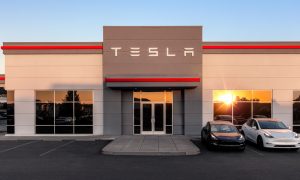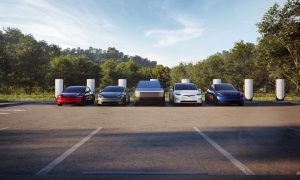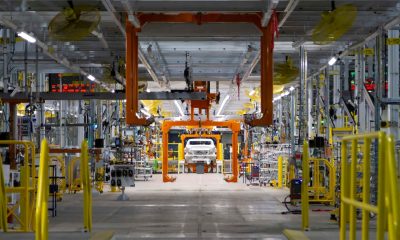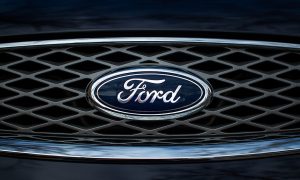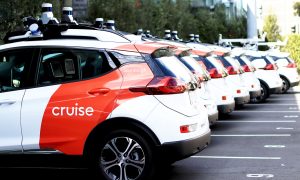Ahead of the General Motors (GM) earnings call this week, the automaker has new union contracts and is expected to report around $10 billion in earnings. However, challenges remain for GM, including electric vehicle (EV) production constraints and the ongoing effects of an accident involving one of its self-driving subsidiary Cruise’s robotaxis in October.
GM will report Q4 and FY 2023 earnings on Tuesday, and the company said in November it expected to earn almost $10 billion throughout 2023—despite around $1.1 billion being lost during historic six-week strikes from the United Auto Workers (UAW) union.
Analysts will be looking to see how GM plans to manage its upcoming launch of the Equinox EV, despite past production issues. In addition, onlookers will want to see how the automaker can navigate its self-driving unit Cruise this year, after an accident with a pedestrian in October rocked operations at the startup.
ARK Invest’s Cathie Wood: Ford and GM’s EV slowdown may benefit Tesla
Morningstar U.S. Auto Equity Analyst David Whiston says he hopes to see what kind of tone CEO Mary Barra and CFO Paul Jacobsen are setting for 2024 during the call, along with the company’s financial expectations given the recent events (via Automotive News).
According to Whiston, this year “should be at least a solid year for them, if not better.”
Other analysts expect the effects of the UAW strikes to have a larger impact on GM’s 2023 numbers, as highlighted by Bank of America analysts in a BofA Global Research note published last week.
“GM and Ford are likely to post a lighter finish to 2023 given pressures from the UAW strike, which impaired production,” the note said. “The greatest focus [will] be on EV expectations since sentiment on electrification has quickly soured.”
In November, GM also announced a $10 billion share buyback plan to help boost Wall Street confidence following the new UAW labor agreement.
EV Production Constraints at GM
GM has struggled to ramp up production of its Ultium EV platform, partially due to an issue with an automation equipment supplier that significantly delayed assembly of battery modules. Last month, the automaker was forced to issue a stop sale on the Blazer EV to address software quality issues.
In November, Barra highlighted the recent production issues, saying that GM “didn’t execute well this year as it relates to demonstrating our EV capability.” In 2024, however, Barra said she expects production to be “significantly higher.”
GM plans to begin production of its upcoming Equinox EV later this year, expected to be a mass-market vehicle priced around $35,000 with shipping.
“That needs to be a flawless launch,” Whiston added. “There’s a space of affordable EVs that Tesla is not in yet, and you don’t want Tesla to be first.”
GM Self-Driving Subsidiary Cruise Runs into Trouble
Along with GM’s need to smooth things out on the production side, the company’s robotaxi company Cruise has been spiraling since one of its driverless vehicles dragged and pinned a pedestrian in October. The startup’s license to operate self-driving vehicles was immediately revoked by the California Department of Motor Vehicles (DMV), which went on to say that the company “misrepresented” and “omitted” critical details about the accident in its follow-up correspondence with the state.
Since then, the company founders have resigned along with several executives, and the GM subsidiary has laid off almost a quarter of its workforce. Following an independent review of the accident from GM-hired law firm Quinn Emanuel, the results of which were shared last week, it was discovered that a lack of internet connectivity may have hindered Cruise’s ability to share video from the incident with regulators.
Cruise is set to appear before the California Public Utilities Commission (CPUC) in a hearing on February 6.
What are your thoughts? Let me know at zach@teslarati.com, find me on X at @zacharyvisconti, or send your tips to us at tips@teslarati.com.
News
Tesla launches in India with Model Y, showing pricing will be biggest challenge
Tesla finally got its Model Y launched in India, but it will surely come at a price for consumers.

Tesla has officially launched in India following years of delays, as it brought its Model Y to the market for the first time on Tuesday.
However, the launch showed that pricing is going to be its biggest challenge. The all-electric Model Y is priced significantly higher than in other major markets in which Tesla operates.
On Tuesday, Tesla’s Model Y went up for sale for 59,89,000 rupees for the Rear-Wheel Drive configuration, while the Long Range Rear-Wheel Drive was priced at 67,89,000.
This equates to $69,686 for the RWD and $78,994 for the Long Range RWD, a substantial markup compared to what these cars sell for in the United States.
🚨 Here’s the difference in price for the Tesla Model Y in the U.S. compared to India.
🚨 59,89,000 is $69,686
🚨 67,89,000 is $78,994 pic.twitter.com/7EUzyWLcED— TESLARATI (@Teslarati) July 15, 2025
Deliveries are currently scheduled for the third quarter, and it will be interesting to see how many units they can sell in the market at this price point.
The price includes tariffs and additional fees that are applied by the Indian government, which has aimed to work with foreign automakers to come to terms on lower duties that increase vehicle cost.
Tesla Model Y seen testing under wraps in India ahead of launch
There is a chance that these duties will be removed, which would create a more stable and affordable pricing model for Tesla in the future. President Trump and Indian Prime Minister Narendra Modi continue to iron out those details.
Maharashtra Chief Minister Devendra Fadnavis said to reporters outside the company’s new outlet in the region (via Reuters):
“In the future, we wish to see R&D and manufacturing done in India, and I am sure at an appropriate stage, Tesla will think about it.”
It appears to be eerily similar to the same “game of chicken” Tesla played with Indian government officials for the past few years. Tesla has always wanted to enter India, but was unable to do so due to these import duties.
India wanted Tesla to commit to building a Gigafactory in the country, but Tesla wanted to test demand first.
It seems this could be that demand test, and the duties are going to have a significant impact on what demand will actually be.
Elon Musk
Tesla ups Robotaxi fare price to another comical figure with service area expansion
Tesla upped its fare price for a Robotaxi ride from $4.20 to, you guessed it, $6.90.

Tesla has upped its fare price for the Robotaxi platform in Austin for the first time since its launch on June 22. The increase came on the same day that Tesla expanded its Service Area for the Robotaxi ride-hailing service, offering rides to a broader portion of the city.
The price is up from $4.20, a figure that many Tesla fans will find amusing, considering CEO Elon Musk has used that number, as well as ’69,’ as a light-hearted attempt at comedy over the past several years.
Musk confirmed yesterday that Tesla would up the price per ride from that $4.20 point to $6.90. Are we really surprised that is what the company decided on, as the expansion of the Service Area also took effect on Monday?
But the price is now a princely $6.90, as foretold in the prophecy 😂
— Elon Musk (@elonmusk) July 14, 2025
The Service Area expansion was also somewhat of a joke too, especially considering the shape of the new region where the driverless service can travel.
I wrote yesterday about how it might be funny, but in reality, it is more of a message to competitors that Tesla can expand in Austin wherever it wants at any time.
Tesla’s Robotaxi expansion wasn’t a joke, it was a warning to competitors
It was only a matter of time before the Robotaxi platform would subject riders to a higher, flat fee for a ride. This is primarily due to two reasons: the size of the access program is increasing, and, more importantly, the service area is expanding in size.
Tesla has already surpassed Waymo in Austin in terms of its service area, which is roughly five square miles larger. Waymo launched driverless rides to the public back in March, while Tesla’s just became available to a small group in June. Tesla has already expanded it, allowing new members to hail a ride from a driverless Model Y nearly every day.
The Robotaxi app is also becoming more robust as Tesla is adding new features with updates. It has already been updated on two occasions, with the most recent improvements being rolled out yesterday.
Tesla updates Robotaxi app with several big changes, including wider service area
News
Tesla Model Y and Model 3 dominate U.S. EV sales despite headwinds
Tesla’s two mainstream vehicles accounted for more than 40% of all EVs sold in the United States in Q2 2025.

Tesla’s Model Y and Model 3 remained the top-selling electric vehicles in the U.S. during Q2 2025, even as the broader EV market dipped 6.3% year-over-year.
The Model Y logged 86,120 units sold, followed by the Model 3 at 48,803. This means that Tesla’s two mainstream vehicles accounted for 43% of all EVs sold in the United States during the second quarter, as per data from Cox Automotive.
Tesla leads amid tax credit uncertainty and a tough first half
Tesla’s performance in Q2 is notable given a series of hurdles earlier in the year. The company temporarily paused Model Y deliveries in Q1 as it transitioned to the production of the new Model Y, and its retail presence was hit by protests and vandalism tied to political backlash against CEO Elon Musk. The fallout carried into Q2, yet Tesla’s two mass-market vehicles still outsold the next eight EVs combined.
Q2 marked just the third-ever YoY decline in quarterly EV sales, totaling 310,839 units. Electric vehicle sales, however, were still up 4.9% from Q1 and reached a record 607,089 units in the first half of 2025. Analysts also expect a surge in Q3 as buyers rush to qualify for federal EV tax credits before they expire on October 1, Cox Automotive noted in a post.
Legacy rivals gain ground, but Tesla holds its commanding lead
General Motors more than doubled its EV volume in the first half of 2025, selling over 78,000 units and boosting its EV market share to 12.9%. Chevrolet became the second-best-selling EV brand, pushing GM past Ford and Hyundai. Tesla, however, still retained a commanding 44.7% electric vehicle market share despite a 12% drop in in Q2 revenue, following a decline of almost 9% in Q1.
Incentives reached record highs in Q2, averaging 14.8% of transaction prices, roughly $8,500 per vehicle. As government support winds down, the used EV market is also gaining momentum, with over 100,000 used EVs sold in Q2.
Q2 2025 Kelley Blue Book EV Sales Report by Simon Alvarez on Scribd
-

 News3 days ago
News3 days agoTesla debuts hands-free Grok AI with update 2025.26: What you need to know
-

 Elon Musk1 week ago
Elon Musk1 week agoElon Musk confirms Grok 4 launch on July 9 with livestream event
-

 Elon Musk6 days ago
Elon Musk6 days agoxAI launches Grok 4 with new $300/month SuperGrok Heavy subscription
-

 News2 weeks ago
News2 weeks agoTesla Model 3 ranks as the safest new car in Europe for 2025, per Euro NCAP tests
-

 Elon Musk2 weeks ago
Elon Musk2 weeks agoxAI’s Memphis data center receives air permit despite community criticism
-

 News5 days ago
News5 days agoTesla begins Robotaxi certification push in Arizona: report
-

 Elon Musk2 weeks ago
Elon Musk2 weeks agoTesla reveals it is using AI to make factories more sustainable: here’s how
-

 Elon Musk2 weeks ago
Elon Musk2 weeks agoTesla scrambles after Musk sidekick exit, CEO takes over sales



